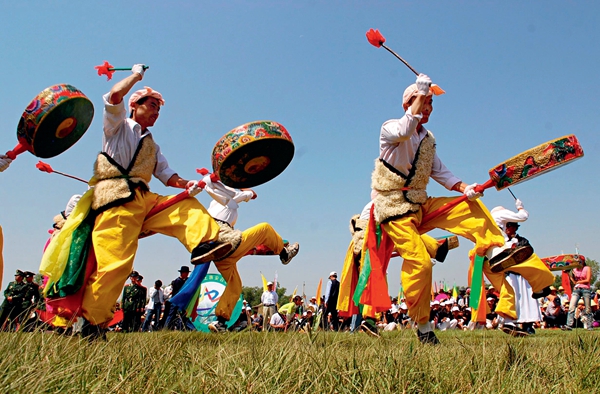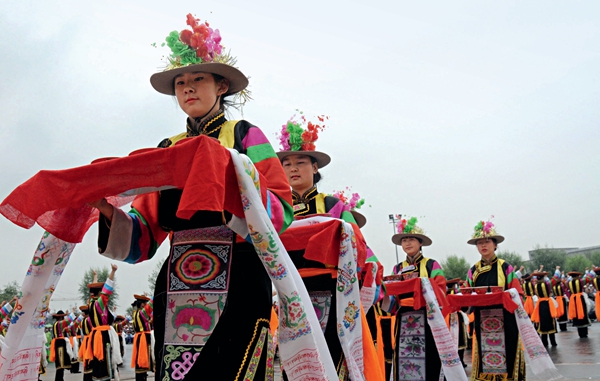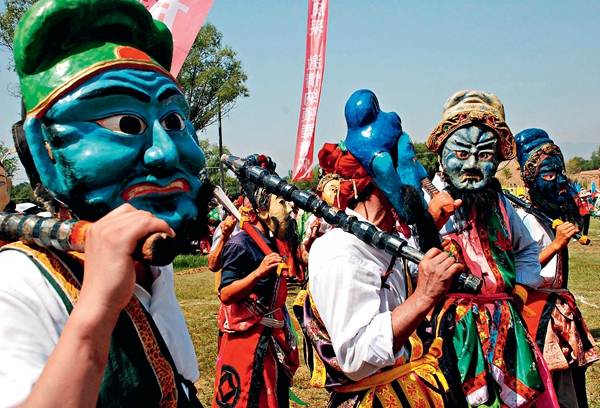
Nadun is an appropriation of the Mongolian word Nadam, meaning to have fun or play. It is a thanksgiving for the Tu people, which happens after the autumn harvest, and is full of entertainment and folk dancing. The date of the festival varies from place to place, most starting around harvest time. The festival on the plains happens earlier than that of the mountainous areas, roughly from mid-July to mid-September on the lunar calendar. It began, in its original form, as a ceremony to worship the god Er-Lang and pray to the local patron saint for good weather and a bumper grain harvest. Now it has evolved into a popular annual folk festival.

According to local folk tales, once upon a time, Qinghai suffered numerous disastrous harvests; not a single grain was reaped for many years. Local people asked the priests to pray for the grace of the gods, but nothing came of it. Later, a wooden statue of the god Er-Lang was brought from Sichuan, which was believed to be the image of Li Erlang, son of Li Bing, the father and son team who had led the construction of the famous irrigation system Dujiangyan. The Tu people built temples in their villages and devotedly worshipped the god, asking him to bless their harvest in autumn. And that year there was good weather for the crops; the harvest had a good yield. The jubilant villagers did not know how to express their immeasurable joy. They put the statues into a large sedan chair carried by eight people, and paraded around the nearby villages to show their gratitude. This was a tale about the beginning of the Nadun Festival. Actually, its history can be traced back even further. The festival first became established when the Tu’s ancestors started to change from a nomadic into a more agrarian lifestyle, and as time went on, the traditional festival became central to the celebration of harvest.
There are group activities that involve each village. Sometimes they are held by one village, sometimes jointly conducted by two villages, with one as the host and the other as the guest. In the morning, families from the host village bring steamed cake, cigarettes, and wine to the threshing area, and offer them as tributes. As the ceremony begins, performers from the host village wait outside the village to welcome performers from the guest village. The two groups form a procession and walk to the threshing floor, carrying multicolored flags to the accompaniment of gongs and drums. At the most exciting moment of the performance, dozens of drums are played in time and dancers jump and shout loudly, showcasing their majestic athleticism and strength.
The large-scale dance performance usually consists of 50 people of all ages. At the front are older villagers, wearing long gowns and holding fans. These people are usually the organizers of the festival and guardians of the Nadun dance, which they have passed down to the younger generations. Although over the age of 60, they are still agile and graceful dancers. Following them are the young people, holding colored flags, and children holding willow twigs. Swinging their arms, they dance around the field. Accompanied by the rhythmic beating of drums and gongs, the dancers jump and swing in time with each other, looking quite graceful and energetic. Meanwhile, the hosts toast the performers with big bowls of liquor to add to the fun. People are enchanted by the dancing, creating a jubilant and joyous atmosphere. And so the Nadun Festival begins.

The performance of the exorcism dance is an important part of the Nadun Festival.
The busy festival naturally provides a good opportunity to visit friends and relatives. Early in the morning, all people, regardless of age and sex, dress up and parade along the country roads in formidable array. Throughout the festival, guests and friends crowd each other’s houses, and all are radiant with joy. They share their best greetings and enjoy the happy festival time together. Hosts treat guests with fine wine and steamed cakes. Travelers who enter the home of a hospitable Tu family will also be received with cordial hospitality. If there are any acrimonious relationships between two people or two villages, they will visit each other to apologize, toasting each other with a big bowl of wine and the disagreement will be resolved as the two are reconciled.
Extensive preparatory work usually starts on the Tomb-sweeping Day. Villagers offer sacrifices to the god Er-Lang and genius Loci. A manager is elected for that year’s Nadun Festival, whose duties include collecting money, maintaining local order, and coordinating with production management before the festival, as well as being in charge of organizing activities. One day before the festival, a large tent is put up in the place where people place statues of the gods and offer sacrifices. A series of rituals are held during the festival, such as invoking the gods, consecrating the ground, making and renewing vows to the gods, and finally saying goodbye.
The festival consists of three parts – the huishou dance (huishou refers to those villagers engaged in ceremonial activities during the festival), the mask dance, and the fala dance.
The Huishou dance is a large-scale collective dance, with up to 100 participants. The dazzling performance often takes different forms and uses a variety of costumes. At the end of the dance, the performers go down on their knees, and the older villagers will sing a song in praise of the gods and express their appreciation that the gods came into this world to share their happiness with people and bless them with great kindness.
After the huishou dance, the performers sit on the ground in a circle and perform folk operettas, an important activity of the Nadun Festival. Since the performers wear masks, it is called a mask dance or exorcism dance.
Zhuangjiaqi is an entertaining dance drama, telling the story of an older farmer teaching his son about farming. Seen as the foundation of Nadun, it is the first play of the festival. The dance of the Three Kingdoms praises the valiant and loyal Guan Yu. Shaguojiang is the finale of the performance, telling the story of Shaguojiang fighting an evil tiger to defend the people. These original dances vividly reflect the Tu people’s undaunted spirit in their fight against natural threats, their abundant historic culture and social life, as well as their romantic mythology.
Fala refers to the intermediary between human beings and the gods, a kind of sorcerer. Fala represents the deity to decree after being possessed. The Fala dance is a ceremony to entertain the gods, including a number of small rites, such as entering the stage, the sorcerer’s dance in a trance, collecting land tax, and declaring an oracle. Fala accepts villagers’ respect and worship on behalf of the gods, and blesses the village with good weather for the crops, a bumper grain harvest, and safety for people and livestock. Villagers take in the oracle and show their gratitude for the blessing. Then they lift a godly sedan to go around the village, and pass it on to people from other villages that will hold their festivals later on.
By means of this activity, the Tu people express their awe and worship to the gods, creating a festival shared by mortals and gods.
With distinct characteristics, the Nadun Festival is a folk activity centered around an exorcism dance. The celebration of this folk religion creates links between villages. The traditional festival lasts a long time and sees extensive participation from many villages. Strict in its organization and order of events, the festival is closely integrated with village management and production, and has an obvious social function. The colorful activities are rich in local detail. The exorcism dance not only maintains the Shamanic culture of northern ethnic groups, but also absorbs features of Han culture, such as the god Er-Lang and the worship of Guan Yu. Expressing the Tu’s cultural individuality as well as promoting cultural symbiosis and national harmony, the festival possesses abundant cultural and artistic connotations as well as local music, dance, costumes, and customs.
Meanwhile, the festival is an oral history of the Tu people, which vividly narrates the Tu’s journey from nomadic life to agricultural production. It is of great significance to the study of the Tu’s history, religion, culture, art, farming, and folk customs.
As a typical mask dance to reflect the Tu’s agricultural concept, Zhuangjiaqi presents the transformation of the ethnic group from nomadic life to permanent settlements. As farming techniques improved and the communication between different cultures increased, the Tu’s ancestors constantly absorbed various cultures, and changed their lifestyle to engage in agricultural production. This transition has been interpreted as a common conflict between father and son.
During the performance, some older villagers would be invited onto the stage, persuading their sons to engage in agriculture. This shows that if family problems and neighborhood disputes cannot be settled satisfactorily, the village elders will be invited to mediate. This method has proved to be effective in mediating neighborhood disagreements, reducing friction, and maintaining social stability. It also reflects the Tu’s respect for the older generations and their emphasis on maintaining good relationships with neighboring villages. The invited elders on stage are usually from other villages; they are toasted with wine to show respect, symbolizing the two villages jointly celebrate a good harvest. The guests are all older males, indicating the deep-rooted patriarchal culture of the Tu people.
The Nadun Festival is a long-standing cultural event. As a traditional cultural gem, the living and historical festival is a jewel in the crown of traditional Chinese culture.
In 2006, the Nadun Festival was listed as a national intangible cultural heritage by the State Council.